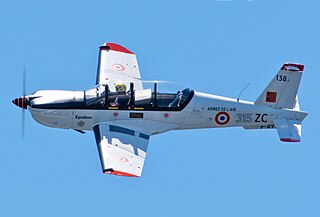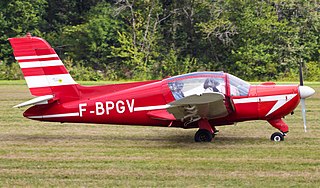
The Piper PA-28 Cherokee is a family of two-seat or four-seat light aircraft built by Piper Aircraft and designed for flight training, air taxi and personal use. The PA-28 family of aircraft comprises all-metal, unpressurized, single piston-engined airplanes with low-mounted wings and tricycle landing gear. They have a single door on the right side, which is entered by stepping on the wing.

The Rutan Model 40 Defiant is a four-seat, twin-engine homebuilt aircraft with the engines in a push-pull configuration. It was designed by aerospace engineer Burt Rutan for the Rutan Aircraft Factory.

The Piper PA-30 Twin Comanche is an American twin-engined cabin monoplane designed and built by Piper Aircraft. It was a twin-engined development of the PA-24 Comanche single-engined aircraft. A variant with counter-rotating propellers was designated the Piper PA-39 Twin Comanche C/R.

The Grumman American AA-1 series is a family of light, two-seat aircraft. The family includes the original American Aviation AA-1 Yankee and AA-1A Trainer, the Grumman American AA-1B Trainer and TR-2, plus the Gulfstream American AA-1C Lynx and T-Cat.
The Bede BD-1 was a two-seat, single-engine, low-wing monoplane, the first design of American aeronautical engineer Jim Bede. The BD-1 was designed in 1960 as a kit-built aircraft intended for home assembly by amateur builders. Design goals included a kit price of $US 2500, including a rebuilt 100 hp (75 kW) engine and a cruise speed of 130 knots (240 km/h). The prototype N624BD first flew in 1962.

The Grumman American AA-5 series is a family of American all-metal, four-seat, light aircraft used for touring and training. The line includes the original American Aviation AA-5 Traveler, the Grumman American AA-5 Traveler, AA-5A Cheetah, and AA-5B Tiger, the Gulfstream American AA-5A Cheetah and AA-5B Tiger, the American General AG-5B Tiger, and the Tiger Aircraft AG-5B Tiger.

The Alpha Aviation Alpha 2000 is a two-seat, all-metal training and general aviation aircraft, designed by Chris Heintz and built in Hamilton, New Zealand. It continues the successful French Apex Aircraft's Robin R2000 series acquired upon Apex's purchase of the Avions Robin company.

The Socata TB 30 Epsilon is a light military trainer aircraft produced by SOCATA. It is a tandem two-seater with a metal airframe. The first prototype flew on 22 December 1979.

The SOCATA Rallye is a light aircraft that was manufactured by French aviation company SOCATA. It was originally developed during the 1950s by French aircraft manufacturer Morane-Saulnier as the MS.880.
The Aerotec A-132 Tangará was a Brazilian military trainer aircraft developed from the A-122 Uirapuru of the 1960s.

The PZL-105 Flaming (flamingo) is a Polish short-takeoff-and-landing (STOL) utility aircraft designed by PZL "Warszawa-Okęcie". It remained a prototype.

The Wassmer WA-51 Pacific is a French four-seat cabin monoplane designed and built by Société Wassmer. Different-powered variants include the Wassmer WA-52 Europa and the Wassmer WA-54 Atlantic. It was the world's first composite material-built aircraft.

The Malmö MFI-10 Vipan was a four-seat light utility monoplane designed and built in Sweden by Malmö Flygindustri. Only three aircraft were built and the type did not enter quantity production.

The GY-80 Horizon is a French four-seat touring monoplane of the 1960s designed by Yves Gardan and built under licence, first by Sud Aviation, and later by that company's SOCATA subsidiary.

The Robin R 3000 is a French single-engined light aircraft designed and built by Avions Robin, which entered production in the 1980s.

The Socata TB is a series of light single-engine piston aircraft developed and manufactured by French aircraft company SOCATA. The letters TB within the designation stand for Tarbes, the French city where the aircraft series is manufactured. The TB series planes have come to be known as the "Caribbean Planes", due to the island naming convention adopted for the various models, though they are not often seen flown in that region.

The Trident TR-1 Trigull is a Canadian amphibious aircraft that was developed by Trident Aircraft of Burnaby, British Columbia and later Sidney, British Columbia. The aircraft was intended to be supplied as a complete ready-to-fly certified aircraft. The company encountered financial difficulties and only three prototypes were ever built.

The Uetz Pelikan is a Swiss four-seat cabin monoplane designed for amateur construction by Walter Uetz.
The Eaves Cougar 1 is an American homebuilt aircraft that was designed by Leonard R. Eaves of Oklahoma City, Oklahoma and made available in the form of plans for amateur construction.

The Lancair 200 and Lancair 235 are a family of American amateur-built aircraft that were designed by Lance Neibauer and produced by his company, Lancair of Redmond, Oregon. The Lancair 200 was initially called the Lancer 200, but the name was changed due to a naming conflict. It was first shown at AirVenture in Oshkosh, Wisconsin in July 1985. Now out of production, when it was available the aircraft was supplied as a kit, for amateur construction.


















